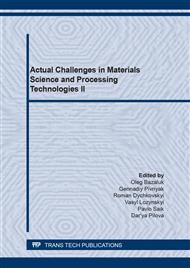[1]
Olga, V.R., Darina, V.I., Alexandr, A.I., & Alexandra, А.O. (2014). Cleanup of Water Surface from Oil Spills Using Natural Sorbent Materials. Procedia Chemistry, 10, 145-150. https://doi.org/10.1016/j.proche.2014.10.025.
DOI: 10.1016/j.proche.2014.10.025
Google Scholar
[2]
Gorova, A., Pavlychenko, A., & Borysovs'Ka, O. (2013). The study of ecological state of waste disposal areas of energy and mining companies. Annual Scientific-Technical Colletion - Mining of Mineral Deposits, 169-172. https://doi.org/10.1201/b16354-29.
DOI: 10.1201/b16354-29
Google Scholar
[3]
Wu, J., Zhang, Y., Pan, W., He, P., Ren, J., Pan, L., & Guo, R. (2010). Evaluation Study on New Sorbents for Mercury in Coal-Fired Flue Gas. Bioinformatics and Biomedical Engineering, 1-4. https://doi.org/10.1109/icbbe.2010.5516561.
DOI: 10.1109/icbbe.2010.5516561
Google Scholar
[4]
Zamparas, M., Tzivras, D., Dracopoulos, V., & Ioannides, T. (2020). Application of Sorbents for Oil Spill Cleanup Focusing on Natural-Based Modified Materials: A Review. Molecules, 25(19), 4522. https://doi.org/10.3390/molecules25194522.
DOI: 10.3390/molecules25194522
Google Scholar
[5]
Feng, Y., Lu, J., Wang, J., Mi, J., Zhang, M., Ge, M., & Wang, W. (2020). Desulfurization sorbents for green and clean coal utilization and downstream toxics reduction: A review and perspectives. Journal of Cleaner Production, 273, 123080. https://doi.org/10.1016/j.jclepro.2020.123080.
DOI: 10.1016/j.jclepro.2020.123080
Google Scholar
[6]
Linnikov O.D., Rodina I.V., Baklanova I.V., & Suntsov A.Yu. (2018). Sorbtsiya ionov medi aktivirovannym uglem marki BAU-A. Sorbtsionnye i khromatograficheskie protsessy, 18(4), 554-562. https://doi.org/10.17308/sorpchrom.2018.18/563.
DOI: 10.17308/sorpchrom.2018.18/563
Google Scholar
[7]
Sreenivasulu, B., Sreedhar, I., Reddy, B.M., & Raghavan, K.V. (2017). Stability and carbon capture enhancement by coal-fly-ash-doped sorbents at a high temperature. Energy & Fuels, 31(1), 785-794. https://doi.org/10.1021/acs.energyfuels.6b02721.
DOI: 10.1021/acs.energyfuels.6b02721
Google Scholar
[8]
Svetkina, O., Netiaga, O., & Tarasova, H. (2015). Sorbents of purify mine waters. New Developments in Mining Engineering 2015: Theoretical and Practical Solutions of Mineral Resources Mining, 111-117. https://doi.org/10.1201/b19901-21.
DOI: 10.1201/b19901-21
Google Scholar
[9]
Nikitin, A.P., Zykov, I.Y., Kozlov, A.P., & Ismagilov, Z.R. (2018). Structure of carbon sorbents produced from coal. Coke and Chemistry, 61(12), 463-468. https://doi.org/10.3103/S1068364X18120062.
DOI: 10.3103/s1068364x18120062
Google Scholar
[10]
Falshtynskyi, V.S., Dychkovskyi, R.O., Lozynskyi, V.G., & Saik, P.B. (2013). Determination of the Technological Parameters of Borehole Underground Coal Gasification for Thin Coal Seams. Journal of Sustainable Mining, 12(3), 8-16. https://doi.org/10.7424/jsm130302.
DOI: 10.7424/jsm130302
Google Scholar
[11]
Czarna-Juszkiewicz, D., Cader, J., & Wdowin, M. (2020). From coal ashes to solid sorbents for hydrogen storage. Journal of Cleaner Production, 122355. https://doi.org/10.1016/j.jclepro.2020.122355.
DOI: 10.1016/j.jclepro.2020.122355
Google Scholar
[12]
Svetkina, O., Tarasova, H., & Netiaga, O. (2016). Multi-purpose sorbent production by coal ash recycling. Mining of Mineral Deposits, 10(1), 77-82. http://dx.doi.org/10.15407/mining10.01.077.
DOI: 10.15407/mining10.01.077
Google Scholar
[13]
Kvashevaya, E., Ushakova, E., & Ushakov, A. (2017). Carbon-Containing Waste of Coal Enterprises in Magnetic Sorbents Technology. E3S Web of Conferences, 21, 01003. https://doi.org/10.1051/e3sconf/20172101003.
DOI: 10.1051/e3sconf/20172101003
Google Scholar
[14]
Mustakhimov, A., & Zeynullin, A. (2020). Scaled-up laboratory research into dry magnetic separation of the Zhezdinsky concentrating mill tailings. Mining of Mineral Deposits, 14(3), 71-77. https://doi.org/10.33271/mining14.03.071.
DOI: 10.33271/mining14.03.071
Google Scholar
[15]
Egorov, P.A., & Meshko, V.D. (1987). Patent No.1344738. Sposobpolucheniya uglerodsoderzhashchego sorbenta. Published 15.10.87, No.33.
Google Scholar
[16]
Yan, F., Jiang, J., Li, K., Tian, S., Zhao, M., & Chen, X. (2015). Performance of Coal Fly Ash Stabilized, CaO-based Sorbents under Different Carbonation – Calcination Conditions. ACS Sustainable Chemistry & Engineering, 3(9), 2092-2099. https://doi.org/10.1021/acssuschemeng.5b00355.
DOI: 10.1021/acssuschemeng.5b00355
Google Scholar
[17]
Maddalone, R.F. (1996). Coal sorbent system for the extraction and disposal of heavy metals and organic compounds. Water Air Soil Pollution, 90, 163-171. https://doi.org/10.1007/BF00619278.
DOI: 10.1007/bf00619278
Google Scholar
[18]
Dubinin, M. (1981). Adsorbtsiya parov vody i mikroporistaya struktura uglerodnykh adsorbentov. Izvestiya AN SSSR, Seriya Khimiya, 9-21.
Google Scholar
[19]
Ivanova, L.S., & Svintsova, L.G. (1960). Issledovanie mekhanizma adsorbtsii elektrolitov aktivnym uglem. Mekhanizm adsorbtsii kislot iz vodnykh rastvorov. Ukrainskiy Khimicheskiy Zhurnal, 26(1), 59-65.
Google Scholar
[20]
Kiselev, A.V (1986). Mezhmolekulyarnye vzaimodeystviya v adsorbtsii i khromatografii, Moskva, Vysshaya shkola.
Google Scholar
[21]
Svietkina, O.Yu., Tarasova, H.V., & Netyaga, O.B. (2018). Utilization of coal waste in sorbents of water purification from radionuclides. Innovative development of resource-saving technologies for mining, 330-354.
Google Scholar
[22]
Svetkina, O. (2012). Monitoring of quality of mineral raw material by method of conductivity. Geo-mechanical Processes During Underground Mining, 151-156. https://doi.org/10.1201/b13157-26.
DOI: 10.1201/b13157-26
Google Scholar


